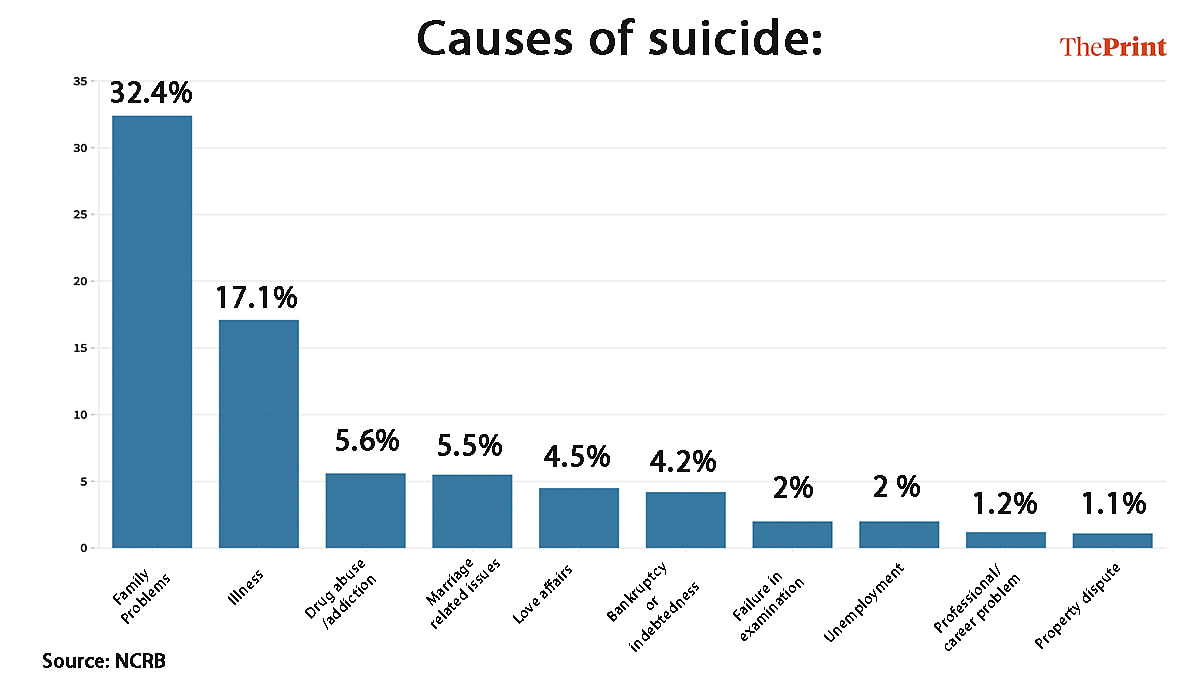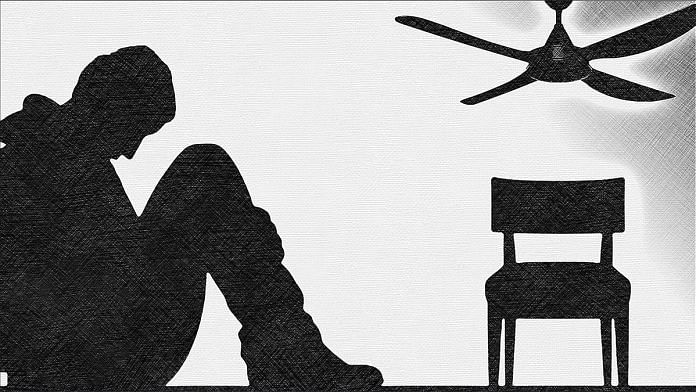New Delhi: At a time when joblessness remains a major challenge across India, data by National Crime Records Bureau (NCRB) showed that at least 2,851 persons killed themselves due to unemployment in 2019.
According to the data released Tuesday, a total of 1,39,123 suicides were reported in India in 2019 — an increase of 3.4 per cent in comparison to 2018, which saw 1,34,516 suicides.
In 2018, 2,741 persons killed themselves due to unemployment, which amounted to 2 per cent of the total suicides.
Maharashtra topped the chart in the total number of suicides, while Karnataka was ahead of others in terms of suicides due to unemployment. This is the second time Karnataka registered the highest number of suicides in the country due to joblessness.

A government official said, “While in 2 per cent of the cases, the cause of suicide was established to be unemployment, in almost 10.1 per cent cases, the people who killed themselves were unemployed, which may or may not have triggered the suicide.”
The data showed at least 14,019 people, who committed suicide, were “unemployed”.
Family problems led to the highest percentage of suicides at 32.4 per cent, the report stated. Drug addiction, career issues, affairs gone wrong and bankruptcy, among others, were other causes of suicides.
Data also showed that most of those who took their own lives due to unemployment fall in the age bracket of 18-30 years.
Of the 2,851 who killed themselves because of unemployment, 62 were below 18 years of age, 1,366 were aged between 18 and 30 years, 1,055 were aged between 30 and 40 years, 313 were between 45 and 60 years, and 55 persons were above 60 years of age.
Moreover, a total of 10,281 persons involved in the farming sector — 5,957 farmers and 4,324 agricultural labourers — killed themselves in 2019 and this amounted to 7.4 per cent of the total suicides.
“Out of 5,957 farmer/cultivator suicides, a total of 5,563 were male and 394 were female. Out of 4,324 suicides committed by agricultural labourers during 2019, 3,749 were male and 575 were female,” the report stated.
Some states and UTs, including West Bengal, Bihar, Odisha, Uttarakhand, Manipur, Chandigarh, Daman and Diu, Delhi, Lakshadweep and Puducherry, reported zero suicides of farmers/cultivators as well as agricultural labourers, the report said.
Also read: 4 school students killed themselves in India every day, shows data
Top 5 states with highest suicides due to unemployment
The NCRB report showed that most number of suicides due to unemployment were reported from Karnataka, followed by Maharashtra, Tamil Nadu, Jharkhand and Gujarat.
While 553 people killed themselves in Karnataka, Maharashtra reported 452 deaths, followed by Jharkhand, which saw 232 deaths, Gujarat 219 deaths, Uttar Pradesh 156 deaths and Assam 155 deaths.
In 2018 as well, Karnataka and Maharashtra reported the maximum suicides due to unemployment with 464 and 394 deaths, respectively.
More male deaths than female
The overall male-female ratio among those who killed themselves in 2019 was 70.2 males to 29.8 females, which is more when compared to 2018 (68.5 males to 31.5 females), the report said.
Out of the total 97,613 male suicides, maximum were committed by daily wage earners (29,092) followed by self-employed persons (14,319) and then those who were unemployed (11,599), according to the report.
Also, most females committed suicides because of ‘marriage related issues’ (specifically dowry related), followed by ‘impotence and infertility’, the report said.
A total of 41,493 females committed suicides in 2019, out of which 21,359 were housewives, followed by students (4,772) and daily wage earners (3,467).
“A total of 17 transgenders have committed suicide. Out of the 17 transgenders, 4 each were unemployed and daily wage earners, 2 were self-employed and one was a student. Six fall under the ‘Other’ category,” the report said.
Data showed that 66.7 per cent (92,757 out of 1,39,123) of those who committed suicides were married, while 23.6 per cent were unmarried (32,852).
Moreover, 66.2 per cent (92,083) were having an annual income of less than Rs 1 lakh, while 29.6 per cent (41,197) belonged to an annual income group of ‘Rs 1 lakh to less than Rs 5 lakh’.

Also read: Percentage of suicides by daily-wage laborers have nearly doubled between 2014 and 2018
‘Family problems led to 32.4% of the suicides’
According to the report, family problems and illness were found to be the major causes of suicides.
While 32.4 per cent of cases were related to family problems, 17.1 per cent were due to ill health.
Drug abuse and addiction amounted to 5.6 per cent of the suicides, marriage-related issues contributed to 5.5 per cent of the cases, love affairs gone wrong amounted to 4.5 per cent, bankruptcy or indebtedness amounted to 4.2 per cent, and failure in examination and unemployment each led to 2 per cent of the suicides.
Professional and career problems amounted to 1.2 per cent of cases and property dispute was the cause for 1.1 per cent of the suicides.
Maharashtra tops suicide charts
Majority of the suicides in 2019 were reported from Maharashtra — 18,916 cases, which amounts to 13.6 per cent of the total cases.
This was followed by 13,493 suicides in Tamil Nadu (9.7 per cent), 12,665 suicides in West Bengal (9.1 per cent), 12,457 suicides in Madhya Pradesh (9.0 per cent) and 11,288 suicides in Karnataka (8.1 per cent).
“These five states together accounted for 49.5 per cent of the total suicides reported in the country. The remaining 50.5 per cent suicides were reported in the remaining 24 states and 7 UTs,” the report said.
“Uttar Pradesh, the most populous state (with 16.9 per cent share of the country’s population) has reported comparatively lower percentage share of suicidal deaths, accounting for only 3.9 per cent of the total suicides reported in the country,” according to the report.
Among all the UTs, Delhi reported the highest number of suicides (2,526 deaths), followed by Puducherry (493 deaths). The remaining UTs together accounted for 2.2 per cent of the total suicides in the country.

Also read: No farmer suicide numbers for second year in a row as NCRB releases crime data for 2017






